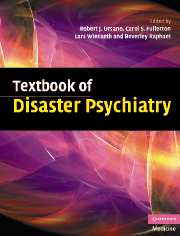Book contents
- Frontmatter
- Contents
- List of contributors
- Preface
- Part I Introduction
- Part II Foundations of disaster psychiatry
- Part III Clinical care and interventions
- Part IV Special topics
- 11 Traumatic death in terrorism and disasters
- 12 Weapons of mass destruction and pandemics: global disasters with mass destruction and mass disruption
- 13 Workplace disaster preparedness and response
- 14 Healthcare systems planning
- Part V Public health and disaster psychiatry
- Index
- References
12 - Weapons of mass destruction and pandemics: global disasters with mass destruction and mass disruption
from Part IV - Special topics
Published online by Cambridge University Press: 09 August 2009
- Frontmatter
- Contents
- List of contributors
- Preface
- Part I Introduction
- Part II Foundations of disaster psychiatry
- Part III Clinical care and interventions
- Part IV Special topics
- 11 Traumatic death in terrorism and disasters
- 12 Weapons of mass destruction and pandemics: global disasters with mass destruction and mass disruption
- 13 Workplace disaster preparedness and response
- 14 Healthcare systems planning
- Part V Public health and disaster psychiatry
- Index
- References
Summary
Some disasters, such as those resulting from weapons of mass destruction (WMD) and pandemics, have the potential for global reach because of the nature of their destructive forces and their effects on individual and community sense of vulnerability, safety and social cohesion. The use of WMD by terrorists gained international attention after the Japanese cult Aum Shinrikyo released sarin gas in the Tokyo subway system in 1995. Concern was heightened when it was learned that the group had also (unsuccessfully) released anthrax and had attempted to obtain the Ebola virus. In the United States, the terrorist attacks of September 11, 2001, and the letters containing anthrax spores that were mailed to media outlets and government officials in October that same year shattered Americans' belief that they were immune from such events. More recently, bombings in London and Madrid and the ongoing suicide attacks in the Middle East are reminders of the psychological and behavioral effects on individuals and communities of terrorism. Although the WMD attacks are often circumscribed, the psychological impact is widespread, as the altered sense of safety and the future resonates to distant sites. Because the ultimate goal of terrorism is to disrupt the social cohesion, values and social capital of a society, protecting and repairing mental health is an important aspect of community preparedness and response planning.
Pandemics also have a potential global reach of mass destruction and historically have been more devastating than any other type of disaster.
Keywords
- Type
- Chapter
- Information
- Textbook of Disaster Psychiatry , pp. 247 - 264Publisher: Cambridge University PressPrint publication year: 2007
References
- 1
- Cited by



